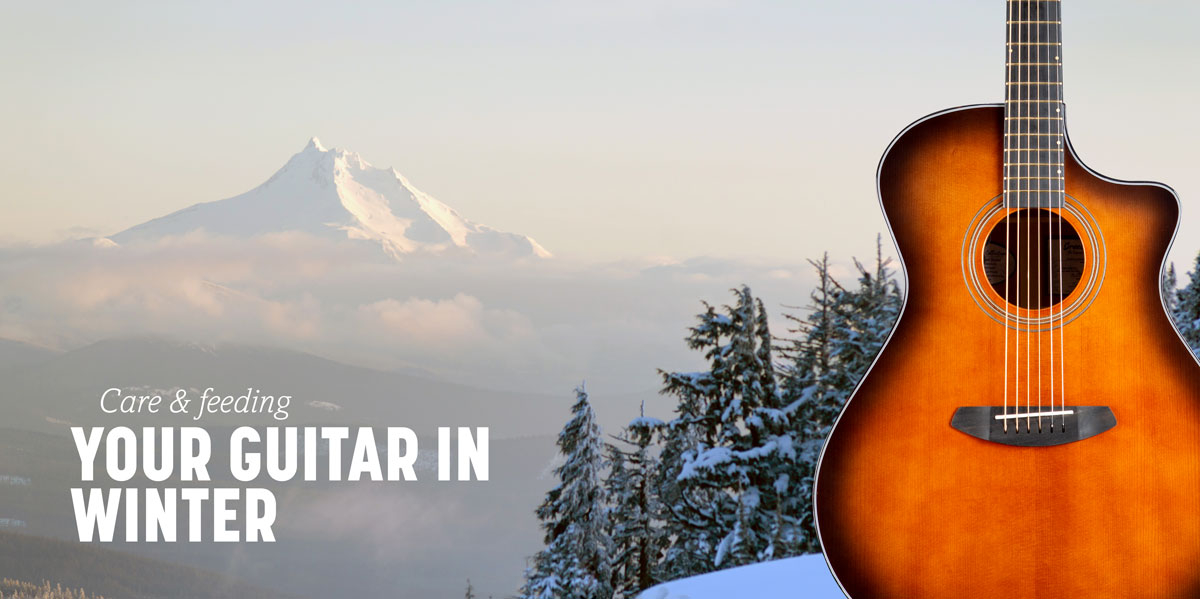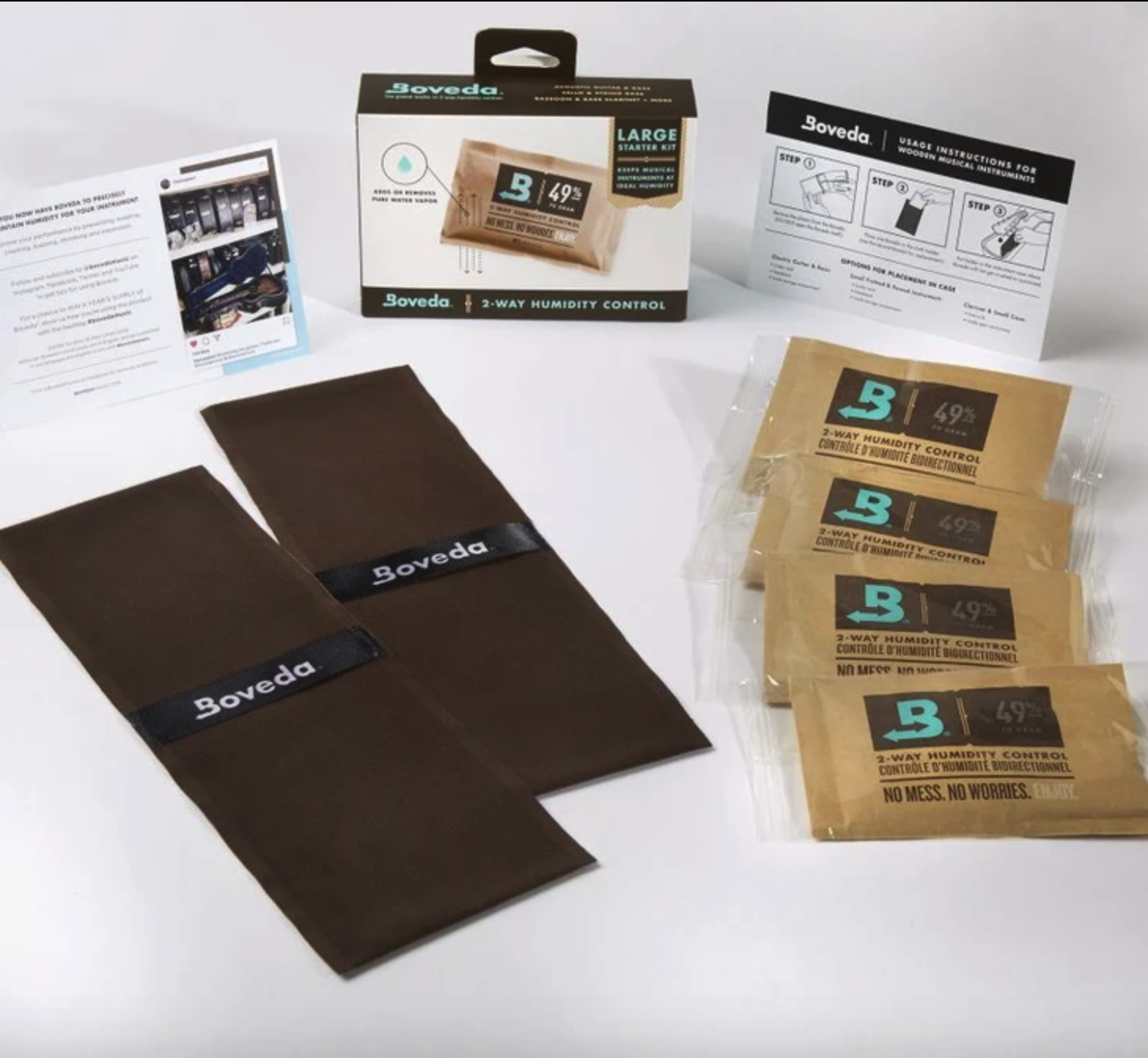

Breedlove Artist Russell Winfield in a Winter Blizzard!
Dry air and fluctuating temperatures can be dangerous—here are some simple, inexpensive tips for cold weather and winter care.
Winter is hard. It’s long and it’s cold.
Guitars don’t like winter. They can’t ski. They can’t skate. And they can’t do that New England thing where you heat up the maple syrup and pour it on the snow.
Guitars, when they are not in your loving hands, tend to want to snuggle up for the winter, in a nice hard case or gig bag, preferably with a little humidification.
Seriously, though, winter can be a challenge for guitars, especially acoustic guitars. And a little knowledge can go a long way in keeping your instrument safe, happy and ready for the next playing session.
Winter air, even in sunnier climes, can be a bit dry. Up north, it’s just frightful, with enough moisture pulled out of the air to sting the nose and create static charges as you walk along the carpet.
The simple way to fight that, for both you and your guitar, is through humidification.
Guitars are made from trees. Therefore, in ways more than just metaphorical, a guitar is a living thing. Wood interacts with its surroundings, literally drinking in moisture when it senses it’s in danger, much the way you fight the wooziness of dehydration by slugging a glass or two from the faucet.
If it gets too dry, say below 40 percent relative humidity, the very thin wood used in guitar tops, backs and sides, can crack or sink. Not only that, but a desperately low level (below 30 percent) can even make for a buzzing action, loose bridge or sharp fret ends at the edge of the neck.
And, lets remember, many favorite tonewoods, like mahogany, rosewood and granadillo, come from regions that don’t experience winter to the same considerable degree, meaning those woods can be especially susceptible to humidity-related issues.
If you’re playing one of Breedlove’s new Organic Collection models, you may have a torrefied European spruce top. Are you loving the aged sound—that comes from a process whereby the wood is essentially roasted, removing much of its native moisture content, and making it sound great, of course, while also making it less susceptible to fluctuations in weather.
But that doesn’t mean a Breedlove Organic Collection model doesn’t need to some tender loving care, too.
So, having established that dry air—particularly in desert locales or during the late fall to early spring heating season—can be a tricky situation for instruments, what do you do about it?
First, when you’re not playing it, put it away. More than ever, in winter a guitar wants to be in its case or in its bag. If you don’t have something to keep it safe, or if you just can’t bear not seeing that beautiful Breedlove axe out in the open, keep it away from heaters, stoves, windows and outside walls, where the temperature difference of the surface and the air inside the house can get confusing.
Some serious collectors dedicate a closed room as a music studio, and display their favorite instruments on stands. You can almost bet they’ve also got a room humidifier keeping things at a steady, safe level.
Guitars can handle different temperatures, within reason, but have a very hard time changing quickly from one environment to another.
If, in the winter, for example, you receive a new guitar by mail or by delivery, you will want to keep it in its box—we know, it’s not easy to be patient—for 24 hours to let it acclimate to the new atmosphere in your house. Similarly if heading out for a gig, let your Breedlove warm up a little at the venue before opening the case.
The big danger here is causing a crack in the instrument’s protective finish by shocking it with a temperature change. It’s heartbreaking to pick up your prized possession only to find it “crazed” like a broken mirror, even if that condition rarely affects the sound.
That room humidifier is a fine idea for everybody, and usually inexpensive, too. It’s good for you and your guitar, and it’s an absolute requirement if you have a number of instruments—in or out of cases. Many have built in hygrometers, which measure the amount of moisture in the air. Again, for guitar health, a relative humidity target between 45 and 50 percent, inside the house, is good. Too much will make it sound like there’s a blanket over your guitar and brings its own consequences, like high action, swollen tops and loose braces.
You can also easily find a small digital hygrometer at the music shop or hardware store.
For one or two guitars, or for traveling, there are a bevy of humidification systems available these days, much more so than in the not too distant dark ages when a green rubber tube with a sponge in it was pretty much the only option.
You can still find the latter, but we’re not fans of it—the way the sponge and the plastic can come in contact with the unfinished wood inside the body is a little scary.
Better are case humidifiers and soundhole units that can be suspended in the strings (rather than covering the soundhole) without touching anything else. These come in a variety of styles and you can choose which best suits you, but in each case carefully follow instructions so that water is never leaking into or onto the instrument. And be vigilant about keeping track. It’s worth it.
The equation is simple. Take care of your guitar, and it will take care of you—for a lifetime.
 Your Humidity Problem, Solved.
Your Humidity Problem, Solved.
Boveda Humidipacks Starter Kit
Welcome to Boveda maintenance-free 2-way humidity control for acoustic guitars, ukuleles, and basses. Boveda creates the perfect humidity balance for your acoustic guitar—whatever its surroundings call for. Boveda products are endorsed by the Breedlove Custom Service and Repairs team! Order from Breedlove here.
